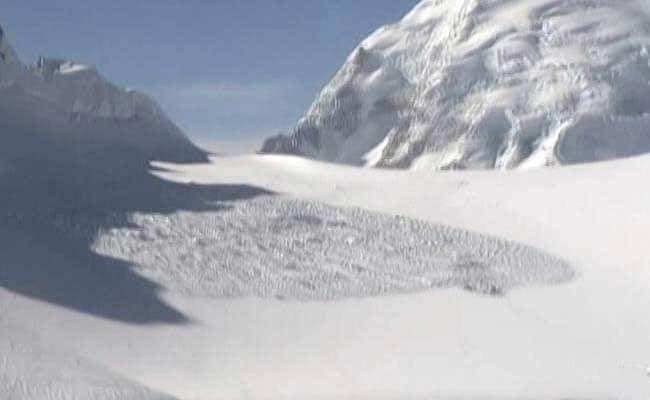Rapid temperature shifts are increasing avalanche risk at Siachen and making the Army remap its posts.
- Variation of 12 degrees in min and max temperatures in 5 years
- Army is forced to relocate posts to minimise avalanche risk
- 41 soldiers have died at Siachen from extreme weather since 2013.
Did our AI summary help?
Let us know.
Siachen:
Soldiers of the Armed Forces at Siachen, the world's highest battlefield, are having to remap their posts. The rapid change in temperatures is causing avalanches in safe areas of the glacier where more soldiers have died from the extreme weather than in battle.
Located at the northern tip of Kashmir, thousands of troops at Sicahen are in constant danger of frostbite and asphyxiation. Besides avalanches, crevasses are opening up "ahead of time" making movement of soldiers even more treacherous. This has affected the induction and de-induction of troops.
Top Ministry officials said that fresh restrictions on movement of soldiers have been imposed. "We have asked soldiers to not move unless it is very necessary," a top official said.
According to top officials in the Ministry of Defence, avalanches in the glacier have gone up by about 20 per cent.
Earlier this year, 10 soldiers died when a huge ice wall collapsed, burying the critical Sonam post, located close to the Line of Control with Pakistan. Lance Naik Hanumanthappa, who was rescued after being buried below 30 feet of snow for six days, could not be saved. The Sonam post was at a height of 19,600 feet. Several posts in this area had to be relocated as the area is now unstable.
Data compiled by the military indicates a 12 degree variation in temperatures in the last five years. The average minimum temperature at the glacier has been rising steadily. In 2012, the average minimum temperature was minus 40 degrees Celsius. In 2014 it rose and minus 37 degrees Celsius, the next year to minus 34 degrees Celsius and in 2016 it stands at minus 30 degrees Celsius.
Similarly, the average maximum temperature of the glacier too is rising. According to data accessed by NDTV, the average maximum temperature in 2012 was 13 degrees Celsius. By 2014, it had risen to 13.5 degrees Celsius and in 2016 to 15.5 degrees Celsius.
"More importantly, winters are setting in later, so the snow isn't hardening leading to an increase in avalanches," Colonel UB Gurung, who commanded the 19 Madras Regiment that lost 10 men at Sonam, told NDTV.
 The Northern Glacier which was earlier considered to be stable is now increasingly seeing avalanches. The Ministry of Defence has asked the Chandigarh-based Snow Avalanche Study Organisation (SASE) to study the changing weather pattern.
The Northern Glacier which was earlier considered to be stable is now increasingly seeing avalanches. The Ministry of Defence has asked the Chandigarh-based Snow Avalanche Study Organisation (SASE) to study the changing weather pattern.
In areas that are considered vulnerable, the Indian Army is digging ditches around post to prevent an avalanche burying entire posts.
Besides restrictions on movement, the Army has also inducted more technology. Apart from daily Avalanche Warning Bulletins which give sector specific warnings, Avalanche Rescue Teams have been prepositioned at vulnerable locations. Also, new equipment like the Avalanche Buoyance Systems - air bags that can be triggered remotely which prevent burial in an avalanche by providing extra buoyancy - have also been inducted.
Located at the northern tip of Kashmir, thousands of troops at Sicahen are in constant danger of frostbite and asphyxiation. Besides avalanches, crevasses are opening up "ahead of time" making movement of soldiers even more treacherous. This has affected the induction and de-induction of troops.
Top Ministry officials said that fresh restrictions on movement of soldiers have been imposed. "We have asked soldiers to not move unless it is very necessary," a top official said.
According to top officials in the Ministry of Defence, avalanches in the glacier have gone up by about 20 per cent.
Earlier this year, 10 soldiers died when a huge ice wall collapsed, burying the critical Sonam post, located close to the Line of Control with Pakistan. Lance Naik Hanumanthappa, who was rescued after being buried below 30 feet of snow for six days, could not be saved. The Sonam post was at a height of 19,600 feet. Several posts in this area had to be relocated as the area is now unstable.
Data compiled by the military indicates a 12 degree variation in temperatures in the last five years. The average minimum temperature at the glacier has been rising steadily. In 2012, the average minimum temperature was minus 40 degrees Celsius. In 2014 it rose and minus 37 degrees Celsius, the next year to minus 34 degrees Celsius and in 2016 it stands at minus 30 degrees Celsius.
Similarly, the average maximum temperature of the glacier too is rising. According to data accessed by NDTV, the average maximum temperature in 2012 was 13 degrees Celsius. By 2014, it had risen to 13.5 degrees Celsius and in 2016 to 15.5 degrees Celsius.
"More importantly, winters are setting in later, so the snow isn't hardening leading to an increase in avalanches," Colonel UB Gurung, who commanded the 19 Madras Regiment that lost 10 men at Sonam, told NDTV.

Movement of troops have been restricted unless absolutely necessary.
In areas that are considered vulnerable, the Indian Army is digging ditches around post to prevent an avalanche burying entire posts.
Besides restrictions on movement, the Army has also inducted more technology. Apart from daily Avalanche Warning Bulletins which give sector specific warnings, Avalanche Rescue Teams have been prepositioned at vulnerable locations. Also, new equipment like the Avalanche Buoyance Systems - air bags that can be triggered remotely which prevent burial in an avalanche by providing extra buoyancy - have also been inducted.
Track Latest News Live on NDTV.com and get news updates from India and around the world

